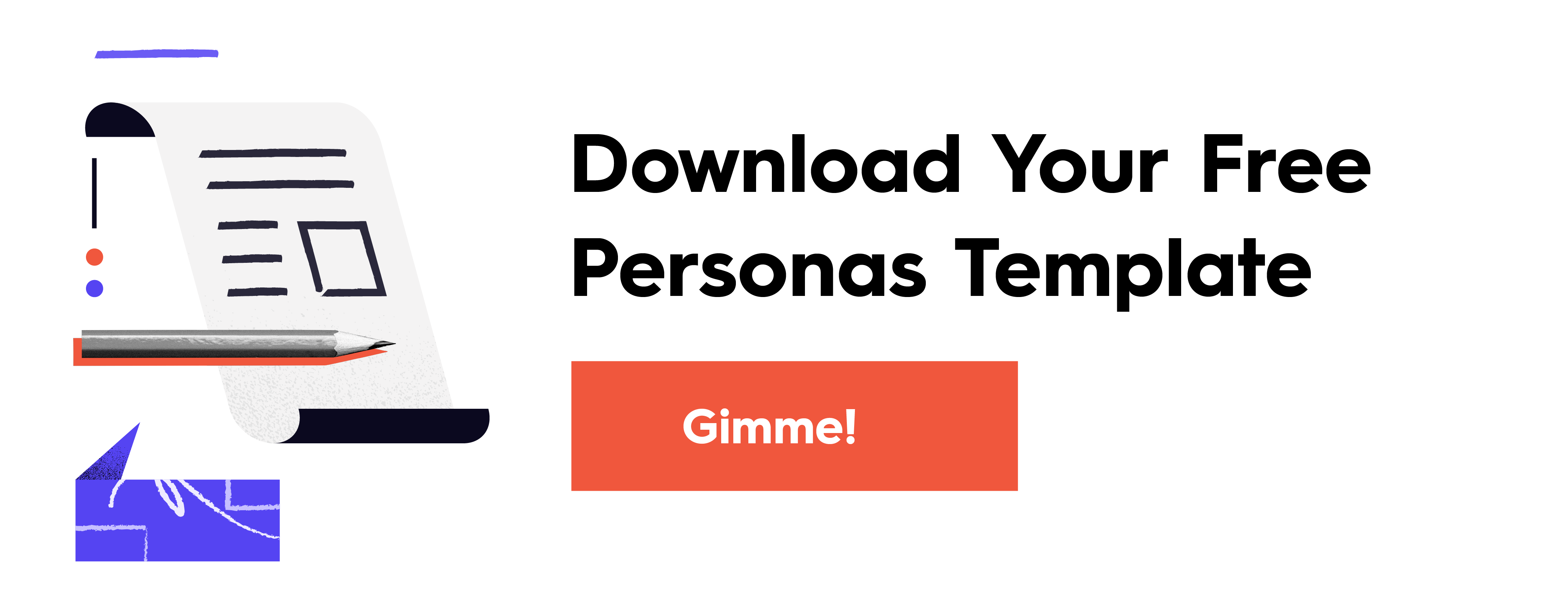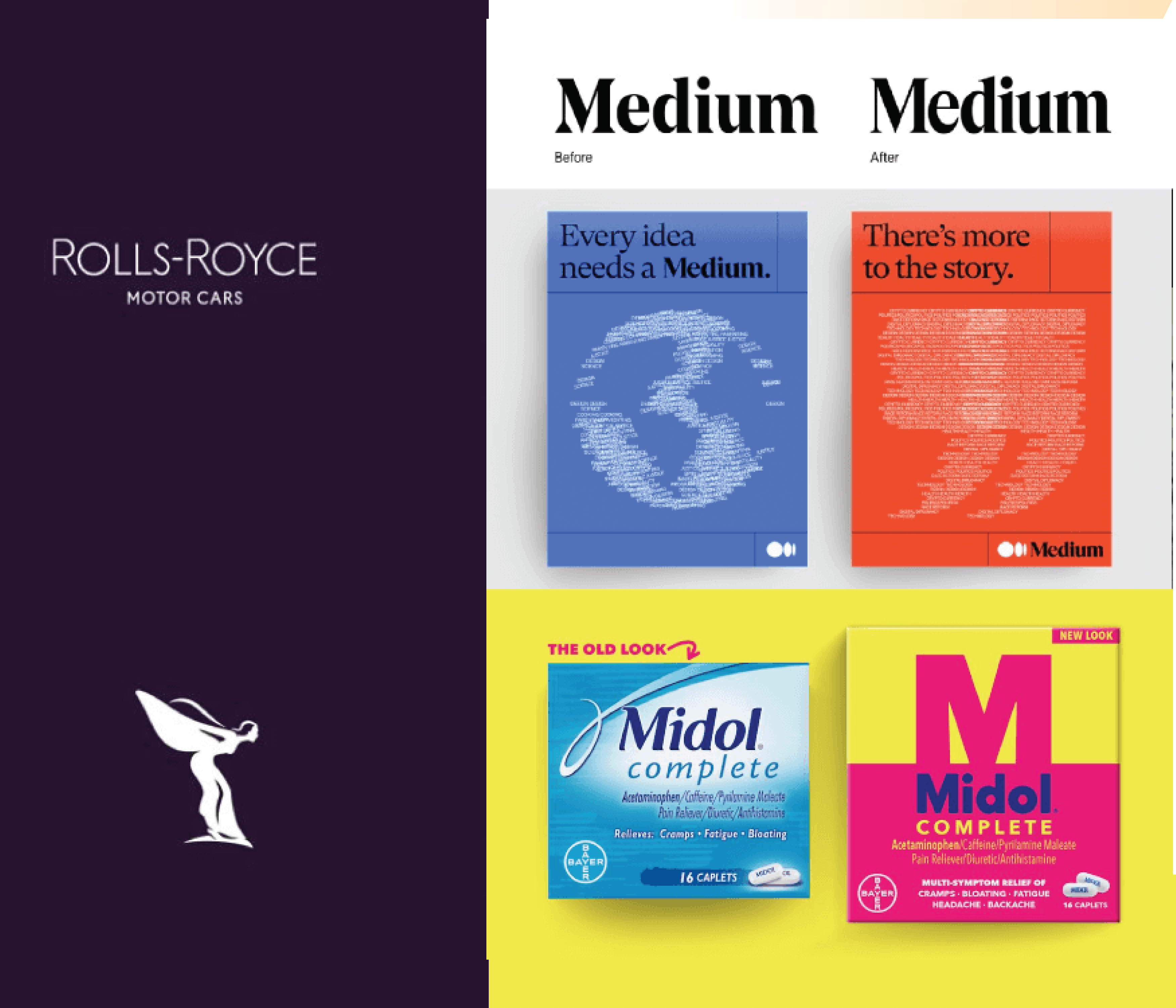We’ve been in business for over a decade, and yet we’re still shocked to see how many clients make the #1 mistake in content marketing: creating content they like instead of coming up with ideas their audience would like. We’ve seen it a million times. You can hire the best designers, the sassiest copywriters, and an Oscar-worthy video crew, but if your content ideas don’t resonate with your audience, they won’t do a damn thing to achieve your marketing goals. That’s why every time a client comes to us complaining about their lackluster content strategy, we always ask to see their marketing personas. You’d be shocked how often they don’t have them documented.
According to the Content Marketing Institute, 44% of marketers don’t use marketing personas to influence their content.
Marketing personas are one of the most valuable tools to transform your content strategy. They hold the key to your audience’s wants, needs, and frustrations. They provide a built-in framework for brainstorming. Yet so many marketers are functioning without them. Or, if they do have them, they’re collecting dust in a document that hasn’t been opened in 3 years.
If you relate to either of these problems, you’ve come to the right place. Here, we’re breaking down everything you need to know about creating marketing personas: why they’re important, how to make them, and what to do once you have them in hand.
What Are Marketing Personas?
In essence, they’re a snapshot of who your audience is and what they’re interested in. They can include a combination of attributes (e.g., age, gender, etc.) and psychographic information (e.g., likes, dislikes, pain points).
Basically, marketing personas are a comprehensive “map” of your audience’s minds and personalities, helping you see the world from their perspective. By compiling these traits and distilling them down into different personas, you create a solid representation of the actual humans you want to attract.
Note: Marketing personas are always used in B2C marketing, but in B2B, you may also want to create Ideal Customer Profiles. These are similar to personas, but instead of individual people, these may refer to the type of business you want to target. For more on this, learn about the differences between personas and ICPs.
How Do Marketing Personas Help Marketers?
Content is the key to creating a strong community of like-minded people who will support your brand long-term. But how do you pique your audience’s interest? Engage them? Convert them? It’s easy; just create the content they care about.
If you don’t understand your audience, you don’t understand your business.
By using personas to get inside your target audience’s mind, you can brainstorm, vet, and tailor your ideas to the right people, ensuring your content is always interesting, relevant, and valuable. This intel can also influence other brand storytelling elements, such as your tone, messaging, or design aesthetic.
Remember: Standing out is more important than ever, especially in a sea of AI-generated content. If you’re working without personas, you’re working without a map, and it will be much harder to grab people’s attention through content marketing.
What Makes a Good Marketing Persona?
We’ve seen every version of “marketing personas.” We’re talking about everything from novel-length writeups to two-sentence descriptions. You don’t want to overwhelm yourself; you want to create a resource that is genuinely useful. That said, there are a few things to keep in mind as you build out your personas
- Accuracy: As you’ll see in this guide, good personas require solid research. Even if you’ve been in business 50 years and think you know everything there is to know about your customers, going to the source is the only way to get the truth.
- Brevity: You want your personas to be thorough, but you can easily drown yourself in data. Admittedly, we’ve been guilty of this in the past, logging every single piece of information about our audience (e.g., what podcasts they listen to, what car they drive, their pet’s name, etc.). While these details can paint a picture of a person, they don’t really speak to their core needs and how you can serve them.
- Utility: There’s no point in doing all the work to create personas for them to be forgotten in a doc somewhere. This is one reason why brevity is so important. If you can create clear, distinct, and distilled personas, you can use them in your day-to-day content practice.
With these elements in mind, we’ve pared down our process to help you create personas that are practical and applicable.
How to Create Marketing Personas in 4 Steps
The Internet is full of all sorts of guides to create good marketing personas. (You may have even checked out a few before you landed here.) Each has its own merit, but the process can feel intimidating and overwhelming, which is why some marketers give up entirely or end up with half-formed personas that don’t really give them the insights they need. We don’t want you to get stuck, so we’ve broken down the process into four simple steps that make it easy.
STOP! Before you dive in, download our free marketing personas template.
This template will guide your conversations with customers and help you craft your finalized personas.
Step 1: Talk to people.
It all starts with a research phase. Even if you have long-standing relationships with your clients, it’s important to take the guesswork out and go directly to the source to interview them about who they are and what they need.
One caveat: If you have an established customer base, you’re in an ideal position. If you’re just starting out and working through product-market fit, look for surveys, studies, and other relevant research that might give you similar insights into your audience. (For more on that, see our tips to find your target audience.)
First, identify the information you want to get from your customers. To do this, take a look at the inputs we’ve included in the template:
- Name
- Age
- Gender (if applicable)
- Job title (if applicable)
- Channels (where you can connect with them)
- Pain points (the barriers to what they want/need)
- How your product/service helps solve their problems (the messages you want your content to deliver)
This is the core information you’ll need to craft your personas, and you can use these attributes to shape the questions you will be asking people. Of course, depending on your unique business, you can add or tweak these inputs as you see fit. (For example, if you’re a makeup brand, you might also want to know what products your audiences are most likely to splurge on.) That said, try to keep your questions simple.
Next, start researching, reaching out, and documenting your findings. You can ask questions via in-person chats, calls, and emails. You can comb through customer surveys, online feedback, or other potentially helpful sources. (For example, we recently looked at the first contact emails we received from leads who became customers in the last year. This helped us identify common themes in why they’d chosen us.)
On that note, it’s also helpful to loop in sales and customer service at this stage, as these are the people who have the most direct contact with your customers and can relay feedback.
Your goal is to gather as much information as possible about your customers so that you can create the most relevant, accurate personas.
Step 2: Consolidate your responses.
If you’ve done your research thoroughly, you probably have a lot of great intel—emphasis on a lot. (And, yes, you may be overwhelmed. Don’t worry, you’ll get more clarity shortly.)
Once you’ve collected your research and responses, gather your team to collate, consolidate, and categorize the info. As you start to log answers, you’ll likely see common themes arise. (This is especially true when it comes to pain points.) For now, list out every potentially helpful data point you’ve discovered. One of the best things about this process is that you will inevitably discover surprising things about your audience—issues you didn’t realize they’re facing, things they like, etc.
For example, after reviewing those first contact emails from our converted customers, we were surprised to see three common themes arise—two of which we’d never prioritized in our messaging or content. This just proves that no matter how much you think you know your customers, they may still surprise you.
Step 3: Write a rough draft.
Block off an hour or 90 minutes, depending on how fast you move and how many personas you’re attempting to map. You might also want to whiteboard this out first to help your team to stay focused.
First, identify how many personas you’re going to create. Your business and your goals should dictate this. We recommend creating 3-5 personas—any more than that and you’re probably getting off course. (When we did this for Column Five, we created 3 different personas and envisioned them as individuals who work at the same organization but at different levels of seniority.)
Next, start to identify your persona segments.
- Name: Give each persona a relevant name.
- Age: You will likely include a range here (e.g., 25-35).
- Gender: Include if applicable.
- Job title: Include if applicable. In lieu of this, you may want to identify another defining characteristic.
- Channels: Identify where they spend the most time online.
- Pain points: You probably have a significant list of pain points. To narrow these down and consolidate them, try to identify three most popular pain points/themes.
- How your product/service helps solve their problems: This should directly address the main pain points you’ve outlined. Let’s say you’re marketing Yum Snackz, a healthy kid snack, to moms. If one of mom’s biggest pain points is a lack of time to make healthy food, you might talk about the grab-and-go convenience of your product.
By the end, you should have a defined group of personas that are both specific and distinct.
Step 4: Finalize your personas.
Once you have your “rough” personas, it’s time to vet them. Circulate your personas for feedback from relevant people (e.g., your sales team or brand team), and refine as needed.
You can also use the info you’ve distilled for each persona to craft a simple story (just a paragraph or so) that captures who the target customer is. This can really help bring your personas to life and make them “stick” in people’s minds.
Let’s go back to our personas for Yum Snackz. Here’s what one persona story might look like:
Sara is a 35-year-old suburban mom of twin boys who are super picky eaters. She has an active lifestyle and wants to feed her kids healthy food. But as the owner of a popular Etsy shop, she doesn’t have the time or energy to make homemade snacks for their preschool lunches. While waiting in her car before school pickup, she was scrolling through Instagram and saw one of her favorite lifestyle bloggers post about how popular Yum Snackz are with her own kids. Sara made a note to pick some up on her next grocery run, and she’s been a fan ever since. Since Yum Snackz are perfectly portioned and easy to take on the go, she can confidently give the boys the nutrition they need without having to think about it. Plus, the variety of delicious flavors lets each finicky boy pick his favorite—without a fight. The truth is Sara loves Yum Snackz so much she keeps one in her yoga bag—just in case she needs a quick fix. But don’t tell the boys that or the snacks will disappear in a snap.
Once you’ve made your edits and have final approval, you can memorialize them in the template, Google Docs, an Excel spreadsheet—whatever works for your team. Just make sure to regularly review and update personas as well, especially any time you make changes to your content strategy.
How to Use Your New Personas
Once you have your brand new personas in hand, put them to work in your content strategy.
- Use empathy when you brainstorm. Whether it’s inspirational, educational, or entertaining, make sure your content delivers something valuable to your audience. Note: If you can’t identify which persona a piece of content is for—and why they would be interested in it—it’s probably not going to work. For more ideas, learn how to do empathetic content marketing, and try these prompts to come up with strong content ideas.
- Adjust your messaging. Personas make it much easier to tailor your brand messaging to different audiences. If you want to emotionally hook them, use our brand messaging framework to tell a unique brand story that resonates with your personas. (This messaging can apply to everything from homepage copy to sales enablement content.)
- Measure your content success. You will likely need to adjust your content strategy on a quarterly basis to keep up with changing markets or audience preferences. But make sure to document and track the right metrics for your content strategy to see how you’re doing.
And if you need help with any aspect of your content strategy, bring in some reinforcements. You can start your search with our content strategy FAQs, or hit us up directly. We’re always down to chat.






This is top-notch!
This is really helpful and informative. Thank you guys.
Happy to help!
Glad you found it helpful.
Love your articles and tool
Kits. So concise and insightful!
Happy to hear it!
Hello this great help thanks.
I was in process of developing personas (Audience Persona) for media content production company that is looking into diversifying content; so o hope to use personas to brainstorm ideas for new content and/or modification of the existing TV program. There is a broad audience profile survey already, so info as starting point but I thinking to identify some audience members for direct, targeting interview for my persona/s, so what is best way to choose these members? I can we say some audience members can be the median/average representative audience members fit for personas?
Thanks for help
Hi Asre, yes, you would choose the members that you want to represent your audience (if you’re looking to narrow). Or, if you have several persona profiles, you may break them down into several sub-groups and interview members of each.
Hey, Thank you so much for helping out,
Can you please tell how can i reach target audience to ask questions, actually tried on LinkedIn in there i can ask in poll ques or I can create google form. I think google form is little old as users do not click the link to give feedback most often. what tools i can use.
Hey Rajan, polls on social are a great option, as they require very little effort on the participant’s part. Unfortunately, when it comes to crafting personas, you have to use every avenue you can to access your customer—social, email, surveys, etc. If you’re having trouble finding them, industry research can help. When we crafted our own personas, we spoke with out current clients and combed through research related to CMO’s biggest pain points, etc. Sometimes you do just have to get a little scrappy.
Thank you for your valuable feedback always.
Great, Thanks for providing valuable feedback always, I have one more question
How can I identify age, Job title & goals of users through quantitative data from “polls”, Also can you please create or share an article on Market Research also, I found your data more valuable then all others in industry.
Hi Rajan, If you are conducting surveys/polls, you can ask the users to submit info like job title, etc. You can crystallize goals by asking them directly about their biggest pain points, needs, or goals. I think you might find Hubspot’s guide to market research helpful for a deeper dive into some of these topics: https://blog.hubspot.com/marketing/market-research-buyers-journey-guide.
Hello,
This was really lovely and insightful, thanks for sharing.
Although, I’ve a wondering questions as regards content marketing.
What medium can be used to reach out to one’s audience when stating out content marketing ?
Can one person carry out content marketing with your guidelines or one’s needs to employ others ?
Hi Anabelle, great question. When you’re just starting out, one person can certainly generate content, although it depends on what type of content you’re creating. Articles, social media content, etc. are the easier things to start with. If you want to design infographics, interactives, or video, you may need to outsource some assistance. Here is a helpful article that breaks down all the different types of content, as well as their difficulty level: https://www.columnfivemedia.com/best-content-marketing-formats-b2b-lead-generation/
Hi,Thanks for providing this content. Only thing I am not able to understand is what type of questions should i ask to users as I want to start teching design on Instagram.
Hi Rajan, if you want to start teaching, you should ask your potential audience/students questions about things like their learning barriers, interests, what they want to learn, what inhibits their learning, etc. You want to understand who they are, the challenges they’re facing/what they want, and how you can provide solutions for those challenges.
Hey, Thank you so much for helping out,
Can you please tell how can i reach target audience to ask questions, actually tried on LinkedIn in there i can ask in poll ques or I can create google form. I think google form is little old as users do not click the link to give feedback most often. what tools i can use.
Hi,
Thanks for the guidance on branding – so far this has been the most useful for me. It is written in an easy to understand way and laid out in a logical order.
One thing to note about your website: This blue dot that appears and follows the cursor is super annoying. I don’t get the point of the blue dot following my cursor. If it is for visually impaired, there are other ways to make your site WCAG compliant.
Keep up the great work! If I ever get tired of doing things by myself, I will reach out to you.
Hi Tamara, thanks for that feedback! We have decided we will be removing it.
I’m a Student and I want to make a Brand of Binoculars because my father is the Manufacturer of All types of Brass Binoculars . So, I want to make trusted Brand from Scratch. What should I do and from Where to Start.
Help me Please……
Sounds exciting. Here are a few resources to help…
1. Start with our guide to build a brand strategy: https://www.columnfivemedia.com/how-to-create-a-brand-strategy/
2. Then you can create your brand identity: https://www.columnfivemedia.com/how-to-create-a-brand-identity/
3. To publicize your brand, you can work on your content strategy: https://www.columnfivemedia.com/how-to-create-a-content-strategy/
Good luck!
I have one thing disturbed hope you answer, I was one designer and I’m trying to build the brand identity to enhance skills so if I falsified information in research steps so would that affect to the end result? Thanks!
If you were a student building a prototype identity for a fictitious brand (and using hypothetical personas), that would not affect the final outcome. However, if you were falsifying information for a client, that is both unethical and ineffective.
Am a designer learning strategy and by far this the best framework l have come across
Thank you, Francis! That’s exactly what we were trying to do. 🙂
Wonderful article!
What are the chances column 5 has an attractive template for memorializing our personas?
Currently have an excel file, but would love an attractive template to reference.
Thanks!
Hey Nathan, here ya go: http://www.columnfivemedia.com/wp-content/uploads/2021/01/Column-Five-Personas-Template.pdf
Hello! Cool article! But I would add more material about what characteristics the character should include. If someone is looking for such material, then I advise you to read the article https://gapsystudio.com/blog/how-to-create-user-personas/.
Hey, I love all this and it’s super helpful. I’m following along. For this step, I struggle with exactly the final version of your market personas look like. Do they look similar to the template but an amalgamation of a few?
I’m stick with what exactly I’m literally trying to tangibly produce. I’ve done about 8 market persona sheets from various people I know. And I’ve collected a ton of anecdotal feedback.
Are you able to frame it and pin point what the final outcome literally is or looks like?
Thank you
Hi Lenny, Great question. Ours look like our templates, with the core details filled in. You can also write up an abridged version/paragraph that includes a name for each, as well as their key wants, fears, or needs. For us, their real utility lies in the ability to vet our ideas. Whether we’re stuck trying to come up with new ideas for a specific audience or ensuring our current content is relevant, we make sure the content maps to a specific persona’s need, want, or concern. Hope that helps!
I love this article. Very insightful. But my issue is gathering information. I’m starting a business but I want to know how to source for specific information that is relevant to my business.
Thank you so much for this. We are a new outdoor advertising company that provides services to a B2B (agencies) dose the marketing personas apply for the B2B too?
Absolutely. Your target audiences have the same drive and motivations, even though they may be more business-centric.
Can I combine a questionnaire along with interviews? We are a new company that provides services to a B2C Niche market and at the moment we find it hard to get enough interview responses.
Absolutely! Any tools that help you get the required info work.
Thank you for the info!
I have a question, can I do it by emailing it?
We find in-person is ideal, but if email is your next best, by all means.
Also, if making a marketing persona for your personal brand or start up business, and it’s solely you on this endeavor. Who are people you should be getting input from? Or can you conduct a marketing persona by yourself?
Whomever you’re trying to reach. Call, text, chat, email any potential customers or people you’re trying to entice. Find out what they need so that you can figure out how to serve them.
Hi, first off I loved this read and the whole site. I do have a question…when making a marketing persona the internal partners who are present in the session, are they speaking from a general standpoint to try and provide answers as if the general public was being surveyed? are they the people whos answers make up the marketing persona?
When we craft personas, we have our internal team in the room to discuss and craft them. But the information we are using to inform our decisions comes from research and conversations about and with our core audience/the people we’re trying to reach.
Interesting!
I’m slightly confused, who are the people we should be surveying?
“Make sure you get everyone who should be part of this activity in the same room (if possible)”
Thank you
Hey Chanice! For this activity, you’ll be having a conversation with internal teams or partners to craft the personas. This could include marketing, sales, an agency, etc. However, the information you’re using to craft those personas should be gleaned from conversations with your potential audience, as well as surveys and research.
Good Luck!
Awesome read. This can also helps with creating copy for marketing materials. Would love to show you where I got with the tips provided and have your thoughts on it!
Maybe I missed it but where is the audience you are creating the persona to describe in your process? Seems their perspective would matter most and be important to include.
Good question, Eric. Absolutely. Our personas are the shorthand for the various audiences/clients we’re trying to reach. The answers to the questions used to assemble those personas come from regular conversations with our clients, as well as our internal research (e.g., post-project customer surveys, etc.). We encourage as much connection and discussion with customers as possible to help inform your personas.
Guys I love this. For real. Can’t wait to try it with my team!
Good luck! Let us know how it goes.